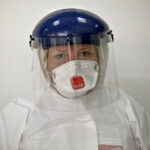
This rapid review asked whether, and in what circumstances lack of eye protection equipment is putting primary care clinicians at risk of contagion compared to use of eye protective equipment such as goggles.
COVID-19 is spread by four means: via contact directly or contaminated surfaces; via droplet infection; via aerosols, and aerosol generating procedures (AGPs) which are created during many routine dental treatments; and finally the faeco-oral through poor hand hygiene. Even though there is limited evidence of Covid-19 virus being present in tears and conjunctival secretions there is a hypothetical risk that the virus could enter the body through the eye as a droplet or aerosol (Sun et al., 2020).
Methods
The Medline and Cochrane library digital databases were searched without date restrictions. Due to the large number of non-peer reviewed preprint publications in circulation they also conducted searches of Google Scholar. Critical appraisal of the systematic reviews was undertaken using the AMSTAR II checklist (Shea et al., 2017).
Results
- 52 randomised controlled trials and 12 systematic reviews were found on Medline.
- 2 systematic reviews were assessed as good quality.
- Verbeek (Verbeek et al., 2020) conducted a comprehensive Cochrane Review on the ‘Personal protective equipment for preventing highly infectious diseases due to exposure to contaminated body fluids in healthcare,’ and concluded there were no recent studies that investigated goggles or face shields.
- French (French et al., 2016) identified two studies in which eye protection was used (eye–nose goggle or goggles plus masks) and found this to be effective in preventing transmission to staff (Agah et al., 1987, Gala et al., 1986). The control groups in both studies however were not wearing PPE so it was impossible to correctly evaluate the protective efficacy of the goggles from the face mask (See Table 1).
Table 1. Results from French 2016.
| Study | Intervention | Control | Transmission risk in intervention group | Transmission risk in Control group |
| Agah et al, 1987 | Goggles, mask and gowns | No mask or goggles | 5% (RSV illness rate) | 61% (RSV illness rate) |
| Gala et al, 1986 | Eye nose goggles | No mask or goggles | 5% | 34% |
*RSV – Respiratory syncytial virus
Conclusion
The authors concluded:-
There is no direct evidence from randomised trials that eye protection equipment alone prevents transmission of COVID-19. Indirect evidence suggests that healthcare workers’ conjunctivae could be exposed to infective droplets and aerosols from patients during close contact. It is important to assess contagion risk of every encounter and take appropriate precautions Where close contact is required, guidance for full personal protective equipment should be followed. For non-AGPs, there is no evidence from randomised trials that eye protective equipment provides additional protection
Comments
In this well conducted rapid review the authors highlight the lack of direct evidence regarding the use of googles or face-shields in both non-AGP and AGP’s. There are many ethical reasons why there are so few studies and therefore current guidance is based on simulations using data from SARS and MERS outbreaks – as well as expert opinion, common sense, custom and practice. There is an urgent need for specific studies to address goggle and face shield performance in the dental surgery environment.
Links
Primary paper
Other References
AGAH, R., CHERRY, J. D., GARAKIAN, A. J. & CHAPIN, M. 1987. Respiratory syncytial virus (RSV) infection rate in personnel caring for children with RSV infections: routine isolation procedure vs routine procedure supplemented by use of masks and goggles. American Journal of Diseases of Children, 141, 695-697.
FRENCH, C. E., MCKENZIE, B. C., COOPE, C., RAJANAIDU, S., PARANTHAMAN, K., PEBODY, R., NGUYEN‐VAN‐TAM, J. S., GROUP, N. R. S., HIGGINS, J. P. & BECK, C. R. 2016. Risk of nosocomial respiratory syncytial virus infection and effectiveness of control measures to prevent transmission events: a systematic review. Influenza and other respiratory viruses, 10, 268-290.
GALA, C. L., HALL, C. B., SCHNABEL, K. C., PINCUS, P. H., BLOSSOM, P., HILDRETH, S. W., BETTS, R. F. & DOUGLAS, R. G. 1986. The use of eye-nose goggles to control nosocomial respiratory syncytial virus infection. JAMA, 256, 2706-2708.
SHEA, B. J., REEVES, B. C., WELLS, G., THUKU, M., HAMEL, C., MORAN, J., MOHER, D., TUGWELL, P., WELCH, V. & KRISTJANSSON, E. 2017. AMSTAR 2: a critical appraisal tool for systematic reviews that include randomised or non-randomised studies of healthcare interventions, or both. BMJ, 358, j4008.
SUN, C.-B., WANG, Y.-Y., LIU, G.-H. & LIU, Z. 2020. Role of the Eye in Transmitting Human Coronavirus: What We Know and What We Do Not Know. Frontiers in Public Health, 8.
VERBEEK, J. H., RAJAMAKI, B., IJAZ, S., SAUNI, R., TOOMEY, E., BLACKWOOD, B., TIKKA, C., RUOTSALAINEN, J. H. & KILINC BALCI, F. S. 2020. Personal protective equipment for preventing highly infectious diseases due to exposure to contaminated body fluids in healthcare staff. Cochrane Database Syst Rev, 4, CD011621.
Picture Credits
By DFID – UK Department for International Development –CC BY 2.0, Link

Can we do the same for post op downtime following an AGP? Is there any evidence?